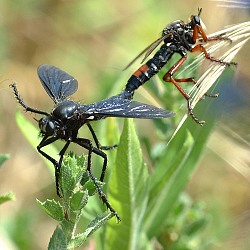|
WOOD (1981): "Courtship behavior varies in the Asilidae. The male may perform a simple chase, capturing the female in the air, or he may undertake short searching flights before catching the female. In some species a more elaborate courtship has also been observed, in which the male searches for the female then hovers in front of her, with legs extended displaying ornamented tarsi, waving the abdomen before mounting and mating. Mating position may be tail to tail, both facing the same way or woth bodies at an angle (Dennis and Lavigne 1975)."
LAVIGNE (2003): "Courtship among the Asilidae has appeared in ten of the thirteen currently recognized subfamilies: Apocleinae, Asilinae, Atomosiinae, Dasypogoninae, Dioctriinae, Laphystinae, Ommatiinae, Stenopogoninae, Stichopogoninae, and Trigonomiminae. The greatest expansion of courtship behaviour, so far reported, has occurred within the Apocleinae and Stenopogoninae. It is postulated that courtship first developed when male search flights (which end abruptly with copulation), were consistently unsuccessful. In the next evolutionary step, males approached females on a substrate and performed a primitive ‘dance’, as seen in both Apocleinae and Stenopogoninae. These ‘dances’ became successively more complex involving epigamic display. Thus, in open environments where the female can be seen for an extended distance, this strategy sufficed. In closed canopy environments, however, it was necessary for males to adopt a more elaborate strategy, which evolved from a simple hover in front of a female to complex manoeuvres involving hovers and epigamic display."
cf. Courtship behavior of Promachus latitarsatus
![Pegesimallus teratodes [Mound, 1990]](images/pegesi.gif) Pegesimallus teratodes: with ornamented tarsi
Pegesimallus teratodes: with ornamented tarsi
|

Mated pair of Dasypogon diadema in tail-to-tail position
|